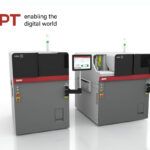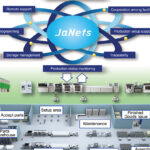ASIA ELECTRONICS INDUSTRYYOUR WINDOW TO SMART MANUFACTURING
ASMPT Touts New Automatic OSC Feeding for SIPLACE TX
Although the processing of odd-shaped components at the end of the line usually accounts for only about ten percent of the entire SMT process, it represents the majority of the challenges in placement operations. Accordingly, ASMPT’s SIPLACE TX high-speed placement systems can now complement as end-of-line machines for the automated processing of odd-shaped components (OSCs). Hence, replacing expensive and slow robotic solutions or manual work.
The SIPLACE Tray Unit enables the automatic, uninterrupted feeding of components from up to 82 JEDEC trays. In addition, the associated seamless traceability of products, components and batches ensures total auditing security, which is particularly important in sensitive areas such as the automotive sector.

“With its proven Waffle Pack Changer and Matrix Tray Changer, ASMPT has long offered the option of automatically supplying odd-shaped components (OSCs) to the highly flexible SIPLACE SX and the high-volume SIPLACE X S. Due to design limitations, this was previously not possible for the SIPLACE TX,” explains Petra Klein-Gunnewigk, Senior Product Manager at ASMPT.
“With the new SIPLACE Tray Unit we fulfill the wish of many electronics manufacturers to make this machine, highly valued for its impressive floorspace performance, fit for automated, highly efficient, and more productive end-of-line processing. As a result, SIPLACE TX users can now balance their lines even more effectively while gaining valuable space on the shop floor. (In addition), increasing their flexibility by integrating processes that previously had to be handled offline – with all the advantages that our Open Automation concept delivers.”
Ready for OSC Processing
To ensure the correct processing of odd-shaped components in a single step, the SIPLACE TX can now be equipped with two stationary high-end camera systems for use with two TwinHeads or a placement head combination of a CPP and a TwinHead. Furthermore, with its great selection of special nozzles and grippers, the TwinHead makes it possible to place OSCs measuring up to 200 mm × 110 mm × 25 mm (L × W × H) and weighing up to 160 grams. Also, with the optional OSC Package, the OSC placement capabilities are expanded even further.
Powerful Feeding Solution
To operate as an end-of-line machine, the SIPLACE Tray Unit is now available for the SIPLACE TX. It uses carriers that can each hold two JEDEC trays. Depending on the size of the components, up to 82 JEDEC trays or 41 trays measuring up to 355 × 275 mm are possible. As a special feature, new trays can be refilled without having to interrupt the production because the magazine is split into a buffer zone for the continuous supply and the main storage area, which can be refilled with new trays.
Perfect fit for More Space
The SIPLACE TX is the placement solution of choice for mobile devices, increasingly complex automotive solutions, and many more applications. Whenever manufacturers wanted to integrate the processing of OSCs into the line, they previously had to resort to alternative end-of-line solutions, which take up significantly more space. For example, three SIPLACE TX and one SIPLACE SX with a Waffle Pack Changer occupy an area of 13.76 square meters. On the other hand, four SIPLACE TX machines, the last being equipped with the new SIPLACE Tray Unit, take up only 9.92 square meters – a whopping 27.5 percent less. Furthermore, the SIPLACE Tray Unit protrudes less than 13 centimeters from the front of the machine.
A More Balanced Line
Automated OSC processing makes the entire SMT line much more balanced because it drastically accelerates the slowest placement process. It increases the line’s productivity considerably and minimizes the robot-supported or manual processing of OSCs or eliminates it completely. Another contributor to an optimally balanced line is the powerful CP20 placement head, the latest generation of which can process components that are one millimeter taller. This makes it possible to process a higher range of components at the beginning of the line, which in turn relieves subsequent machines.

Automation for the Integrated Smart Factory
Integrating the placement of OSCs into the SMT line also enables this process to benefit from the wide-ranging capabilities of ASMPT’s flexible and manufacturer-independent Open Automation concept. In contrast to downstream manual processes, all production, product and component data is automatically recorded during the placement process and transmitted to the IT systems for seamless traceability and documentation. In addition, the productivity- and efficiency-enhancing applications of the WORKS smart shop floor management suite can also be used to their full extent for the OSC process – another important step toward the integrated smart factory.
End-of-Line Processing in ‘Facts on Open Automation’
What the ideal end-of-line machine must look like is the subject of our ‘Facts on Open Automation’ livestream on March 29. Most importantly, host Laszlo Sereny and his studio guests will explain why component diversity and standardization are not mutually exclusive and prove this with illustrative examples from practical applications.
This ASMPT show format offers viewers each month a roughly half-hour English-language livestream around ASMPT’s Open Automation concept. In addition, it will have live feeds from international SMT hot-spots, interviews with experts, practical examples from SMT productions, and much more.




